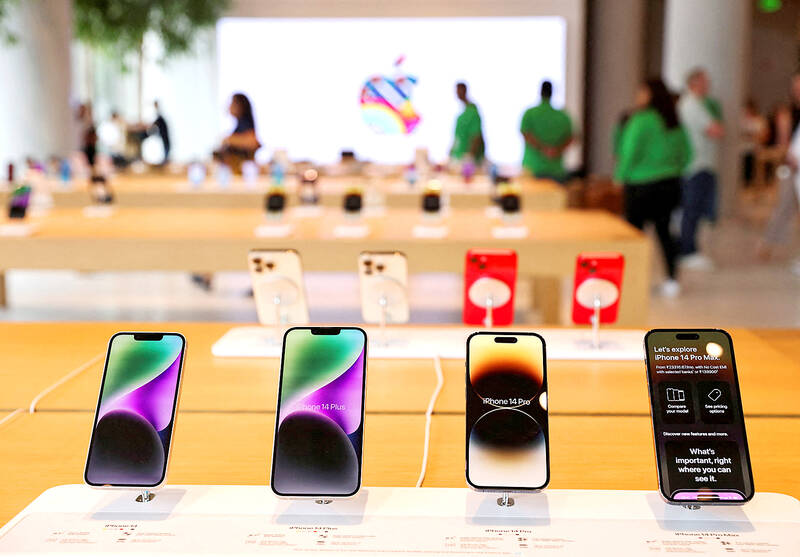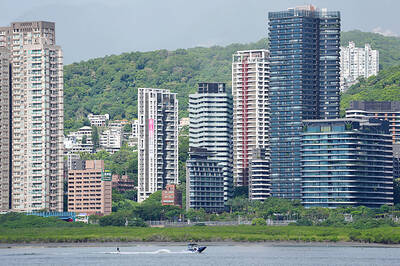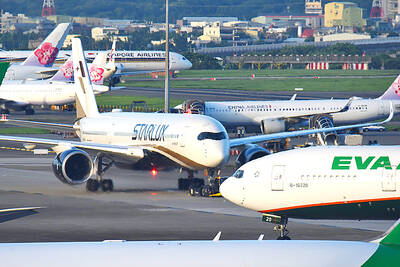Apple Inc’s iPhone exports from India soared by one-third in the six months through last month, underscoring its push to expand manufacturing in the country and reduce dependence on China.
The US company exported nearly US$6 billion of India-made iPhones, a one-third increase in value terms from a year earlier, people familiar with the matter said.
The dollar figure refers to the devices’ estimated factory gate value, not the retail price.

Photo: Reuters
Apple is expanding its manufacturing network in India at a rapid clip, taking advantage of local subsidies, a skilled workforce and advances in the country’s technological capabilities. India is a crucial part of the company’s effort to lessen its reliance on China, where risks have grown along with Beijing’s tensions with the US.
Three of Apple’s suppliers — Taiwan’s Foxconn Technology Group (富士康) and Pegatron Corp (和碩), and homegrown Tata Electronics Pvt Ltd — assemble iPhones in southern India. Foxconn’s local unit, based on the outskirts of Chennai, is the top supplier in India and accounts for half of the country’s iPhone exports.
Salt-to-software conglomerate Tata Group’s electronics manufacturing arm exported about US$1.7 billion in iPhones from its factory in Karnataka state from April to last month, the people said.
Tata acquired the unit from Taiwan’s Wistron Corp (緯創) last year, becoming the first Indian assembler of Apple’s bestselling product.
IPhones account for the bulk of India’s smartphone exports and helped the product category become the top export to the US at US$2.88 billion in the first five months of this fiscal year, government data showed.
Five years ago, before Apple expanded manufacturing in India, the country’s annual smartphone exports to the US were a meager US$5.2 million.
To be sure, Apple relies on China for a bulk of its manufacturing and sales, and India is unlikely to become its top market anytime soon.
However, subsidies from Indian Prime Minister Narendra Modi’s administration helped Apple assemble its pricey iPhone 16 Pro and Pro Max models, with better cameras and titanium bodies, in India this year.
The company is also seeking to open new retail stores, including in the southern tech hub of Bengaluru and the western city of Pune, after launching its first shops in the financial hub of Mumbai and the capital, New Delhi, last year.
Apple assembled US$14 billion of iPhones in India in the fiscal year through March, doubling production and accelerating its drive to diversify beyond China. Of that, it exported about US$10 billion worth of iPhones.
Separately, Apple on Monday rolled out its first set of Apple Intelligence features across its premium iPhone, iPad and Mac devices and introduced a new 24-inch iMac desktop with an AI-focused M4 processor.
The iMac, starting at the same US$1,299 price as the previous model, is faster and sports an enhanced Neural Engine for handling artificial intelligence (AI) tasks, the company said in an announcement.
Apple on Monday began taking orders for the new model, which arrives in stores on Friday next week.
Although Apple previewed a broader set of AI capabilities in June, the initial features represent only a sliver of its plans for the service. The lineup includes writing tools for summarizing and editing text, a new visual interface for the Siri digital assistant, and the ability to recap incoming text messages and other notifications.
Some of the most anticipated Apple Intelligence capabilities are not coming until December. That includes an integration with ChatGPT and tools for editing images and creating custom emojis, as well as automatic sorting of messages in the iPhone’s e-mail app.
An upgraded Siri and support for devices in the EU would not arrive until April.

Taiwan’s rapidly aging population is fueling a sharp increase in homes occupied solely by elderly people, a trend that is reshaping the nation’s housing market and social fabric, real-estate brokers said yesterday. About 850,000 residences were occupied by elderly people in the first quarter, including 655,000 that housed only one resident, the Ministry of the Interior said. The figures have nearly doubled from a decade earlier, Great Home Realty Co (大家房屋) said, as people aged 65 and older now make up 20.8 percent of the population. “The so-called silver tsunami represents more than just a demographic shift — it could fundamentally redefine the

The US government on Wednesday sanctioned more than two dozen companies in China, Turkey and the United Arab Emirates, including offshoots of a US chip firm, accusing the businesses of providing illicit support to Iran’s military or proxies. The US Department of Commerce included two subsidiaries of US-based chip distributor Arrow Electronics Inc (艾睿電子) on its so-called entity list published on the federal register for facilitating purchases by Iran’s proxies of US tech. Arrow spokesman John Hourigan said that the subsidiaries have been operating in full compliance with US export control regulations and his company is discussing with the US Bureau of

Businesses across the global semiconductor supply chain are bracing themselves for disruptions from an escalating trade war, after China imposed curbs on rare earth mineral exports and the US responded with additional tariffs and restrictions on software sales to the Asian nation. China’s restrictions, the most targeted move yet to limit supplies of rare earth materials, represent the first major attempt by Beijing to exercise long-arm jurisdiction over foreign companies to target the semiconductor industry, threatening to stall the chips powering the artificial intelligence (AI) boom. They prompted US President Donald Trump on Friday to announce that he would impose an additional

China Airlines Ltd (CAL, 中華航空) said it expects peak season effects in the fourth quarter to continue to boost demand for passenger flights and cargo services, after reporting its second-highest-ever September sales on Monday. The carrier said it posted NT$15.88 billion (US$517 million) in consolidated sales last month, trailing only September last year’s NT$16.01 billion. Last month, CAL generated NT$8.77 billion from its passenger flights and NT$5.37 billion from cargo services, it said. In the first nine months of this year, the carrier posted NT$154.93 billion in cumulative sales, up 2.62 percent from a year earlier, marking the second-highest level for the January-September